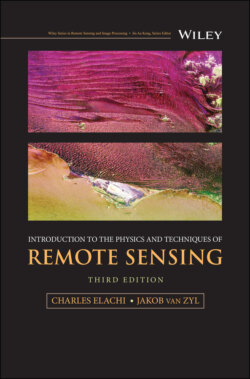Читать книгу Introduction to the Physics and Techniques of Remote Sensing - Jakob J. van Zyl - Страница 13
1.1 Types and Classes of Remote Sensing Data
ОглавлениеThe type of remote sensing data acquired is dependent on the type of information being sought, as well as on the size and dynamics of the object or phenomena being studied. The different types of remote sensing data and their characteristics are summarized in Table 1.1. The corresponding sensors and their role in acquiring different types of information are illustrated in Figure 1.1.
Two‐dimensional images are usually required when high‐resolution spatial information is needed, such as in the case of surface cover and structural mapping (Figs. 1.2 and 1.3), or when a global synoptic view is instantaneously required, such as in the case of meteorological and weather observations (Fig. 1.4). Two‐dimensional images can be acquired over wide regions of the electromagnetic spectrum (Fig. 1.5) and with a wide selection of spectral bandwidths. Imaging sensors are available in the microwave, infrared (IR), visible, and ultraviolet parts of the spectrum using electronic and photographic detectors. Images are acquired by using active illumination, such as radars or lasers; solar illumination, such as in the ultraviolet, visible, and near infrared; or emission from the surface, such as in thermal infrared, microwave emission (Fig. 1.6), and x‐ and gamma‐rays.
Table 1.1 Types of remote sensing data.
| Important type of information needed | Type of sensor | Examples of sensors |
|---|---|---|
| High spatial resolution and wide coverage | Imaging sensors, cameras | Large‐format camera (1984), Seasat imaging radar (1978), Magellan radar mapper (1989), Mars Global Surveyor Camera (1996), Mars Rover Camera (2004 and 2014), Cassini Camera (2006) |
| High spectral resolution over limited areas or along track lines | Spectrometers, spectroradiometers | Shuttle multispectral imaging radiometer (1981), Hyperion (2000) |
| Limited spectral resolution with high spatial resolution | Multispectral mappers | Landsat multispectral mapper and thematic mapper (1972–1999), SPOT (1986–2002), Galileo NIMS (1989) |
| High spectral and spatial resolution | Imaging spectrometer | Spaceborne imaging spectrometer (1991), ASTER (1999), Hyperion (2000) |
| High accuracy intensity measurement along line tracks or wide swath | Radiometers, scatterometers | Seasat (1978), ERS‐1/2 (1991, 1997), NSCAT (1996), QuikSCAT (1999), SeaWinds (2002) scatterometers |
| High accuracy intensity measurement with moderate imaging resolution and wide coverage | Imaging radiometers | Electronically scanned microwave radiometer (1975), SMOS (2007) |
| High accuracy measurement of location and profile | Altimeters, sounders | Seasat (1978), GEOSAT (1985), TOPEX/Poseidon (1992), and Jason (2001) altimeter, Pioneer Venus orbiter radar (1979), Mars orbiter altimeter (1990) |
| Three‐dimensional topographic mapping | Scanning altimeters and interferometers | Shuttle Radar Topography Mission (2000) |
| Surface displacement mapping | Radar interferometer | Sentinel (2012, 2016), SkyMed (2007), ALOS (2006), TANDEMX (2010), ALOS‐2 (2014) |
Spectrometers are used to detect, measure, and chart the spectral content of the incident electromagnetic field (Figs. 1.7 and 1.8). This type of information plays a key role in identifying the chemical composition of the object being sensed, be it a planetary surface or atmosphere. In the case of atmospheric studies, the spatial aspect is less critical than the spectral aspect due to the slow spatial variation in the chemical composition. In the case of surface studies, both spatial and spectral information are essential, leading to the need for imaging spectrometers (Figs. 1.9 and 1.10). The selection of the number of spectral bands, the bandwidth of each band, the imaging spatial resolution, and the instantaneous field of view leads to trade‐offs based on the object being sensed, the sensor data‐handling capability, and the detector technological limits.
Figure 1.1 Diagram illustrating the different types of information sought after and the type of sensor used to acquire this information. For instance, spectral information is acquired with a spectrometer. Two‐dimensional surface spatial information is acquired with an imager such as a camera. An imaging spectrometer also acquires for each pixel in the image the spectral information.
Figure 1.2 Landsat MSS visible/near IR image of the Imperial Valley area in California.
Figure 1.3 Folded mountains in the Sierra Madre region, Mexico (Landsat MSS).
Figure 1.4 Infrared image of the western hemisphere acquired from a meteorological satellite.
In a number of applications, both the spectral and spatial aspects are less important, and the information needed is contained mainly in the accurate measurement of the intensity of the electromagnetic wave over a wide spectral region. The corresponding sensors, called radiometers, are used in measuring atmospheric temperature profiles and ocean surface temperature. Imaging radiometers are used to spatially map the variation of these parameters (Fig. 1.11). In active microwave remote sensing, scatterometers are used to accurately measure the backscattered field when the surface is illuminated by a signal with a narrow spectral bandwidth (Fig. 1.12). One special type of radiometer, or scatterometer, is the polarimeter, in which the key information is embedded in the polarization state of the transmitted, reflected, or scattered wave. The polarization characteristic of reflected or scattered sunlight provides information about the physical properties of planetary atmospheres.
Figure 1.5 Multispectral satellite images of the Los Angeles basin acquired in the visible, infrared, and microwave regions of the spectrum. See color section.
Figure 1.6 Passive microwave image of Antarctic ice cover acquired with a spaceborne radiometer. The color chart corresponds to the surface brightness temperature. See color section.
In a number of applications, the information required is strongly related to the three‐dimensional spatial characteristics and location of the object. In this case, stereo imagers, altimeters, and interferometric radars are used to map the surface topography (Figs. 1.13–1.16), and sounders are used to map subsurface structures (Fig. 1.17) or to map atmospheric parameters (such as temperature, composition, and pressure) as a function of altitude (Fig. 1.18).
